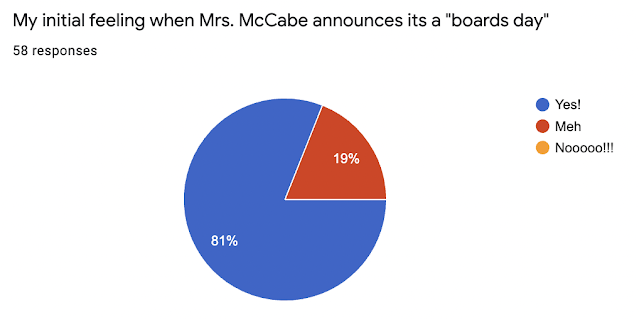Let me just summarize this up quickly.
Vertical white boards have changed my teaching.
Vertical white boards have increased the amount of thinking in my classroom.
Vertical white boards have made math accessible to everyone.
Vertical white boards have helped students develop a growth mindset.
Vertical white boards made learning fun!
In fact, I had one class who would ask every single day..."Boards today?"
And when my answer was YES, the students would cheer.
Yes.
You read that right.
They would cheer to do math.
Markers was the one thing that we struggled with.
We went through A LOT of markers.
Markers seemed to walk off at times to other boards.
Next year, I will make a greater effort to allow only one marker per board.
To help with this, I bought broom holders that I will attach to the boards.
Another change we will be making next year
To help with our functions and graphing unit,
Will be to attach large sheets of laminated graph paper to the boards.
This way, students can complete problems
And everyone can see their work.
Speaking of seeing the work on other boards,
This developed into a useful tool as time progressed.
We started the year with conversations of how valuable it was
to look at all the boards when solving a problem.
At first students felt like they were cheating.
But as we progressed through problems
They started to realize how useful the other boards could be to get unstuck.
Any idea...even an idea that isn't correct,
Could be the catalyst of correctly finding a solution to the problem.
Thinking also was increased with viewing others' boards.
As work and possible solutions were compared,
Students had to think through their thinking to justify their solution.
When asked about using the vertical white boards in their math learning,
here's what the students had to say.
The best part of working at the boards...
"After working on a problem we get to discuss what we did."
"The best part about boards is it is 2 or 3 brains thinking instead of just one."
"It's not as boring, because you can discuss what you're doing with your partner and pick how to approach it rather than having to do it one way."
"Getting to see what other people are thinking."
"As you call it when you have 'ohhhh' moment and understand."
"That's usually when I learn the most."
"You get to see things from other people's perspective and you get to hear and see how to do things differently."
"You get to watch other people do math and see people do math different than you so you learn how to do some new math."
What is not liked about working at the boards...
"You can get paired with people that don't want to talk so it's hard communicating."
"Getting partners that don't want to work."
"The teacher couldn't be at everyone's whiteboard."
"I didn't like everyone looking at my board when I didn't know what I was doing."
"The time limit. I think it's better to have a little bit more time to solve or check the problem."
"Feeling rushed."
How did the boards help (or hinder) your math learning...
"They help because I can see where I went wrong by looking at other boards."
"The boards help me because it lets me picture the problem better."
"You can get rid of mistakes easily."
"They help us put our information down instead of just trying to keep track of it in our heads."
"It helps when you get feedback from others to see if you did it right."
"It helped by changing the way I look at math."
(Whoa. That's huge.)
When a problem was solved at the boards, how did you feel?
"Awesome...like I accomplished something."
"It makes me feel great and I want to do another one."
"It made me really excited and made me feel good like I can actually do something."
"It makes me feel like I conquered the math problem."
"It made me feel good and want to try to keep solving math problems."
"It made me feel good and confident about the next one."
One of the true tests of this is when students that rarely engage
Are seen up at the boards working away.
My principal, on more than one occasion,
Has walked in my room and was surprised to see so-and-so totally engaged.
Now that is a testament of the power of where students work.






